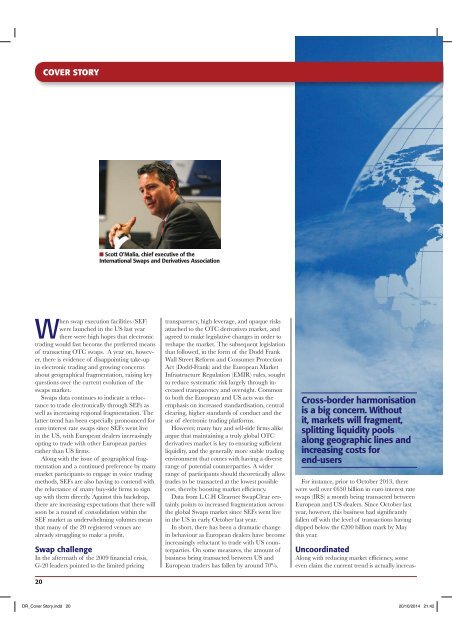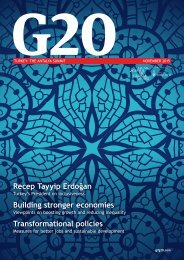SOURCE: Derivatives Special Report
SOURCE Derivatives Special Report provides expert analysis and information on the derivatives markets and provides insight into the large and complex challenges being faced by the global derivatives industry. SOURCE Derivatives Special Report strives to identify emerging risks and mitigation strategies, while covering the fascinating people who drive the industry forward. The magazine will be published in June and November 2015 and quarterly from 2016 with the launch of our website, sourcederivatives.com in September 2015. SOURCE Derivatives Special Report is the leading analytical publication on derivatives, providing a detailed study of theoretical models and how they are used in practice. SOURCE Derivatives Special Report gives you results-oriented analysis and statistical information on derivative products and techniques.
SOURCE Derivatives Special Report provides
expert analysis and information on the derivatives
markets and provides insight into the large and
complex challenges being faced by the global
derivatives industry.
SOURCE Derivatives Special Report strives to
identify emerging risks and mitigation strategies,
while covering the fascinating people who drive
the industry forward.
The magazine will be published in June and
November 2015 and quarterly from 2016 with
the launch of our website, sourcederivatives.com
in September 2015.
SOURCE Derivatives Special Report is the
leading analytical publication on derivatives,
providing a detailed study of theoretical models
and how they are used in practice.
SOURCE Derivatives Special Report gives you
results-oriented analysis and statistical information
on derivative products and techniques.
Create successful ePaper yourself
Turn your PDF publications into a flip-book with our unique Google optimized e-Paper software.
COVER STORY<br />
■ Scott O’Malia, chief executive of the<br />
International Swaps and <strong>Derivatives</strong> Association<br />
When swap execution facilities (SEF)<br />
were launched in the US last year<br />
there were high hopes that electronic<br />
trading would fast become the preferred means<br />
of transacting OTC swaps. A year on, however,<br />
there is evidence of disappointing take-up<br />
in electronic trading and growing concerns<br />
about geographical fragmentation, raising key<br />
questions over the current evolution of the<br />
swaps market.<br />
Swaps data continues to indicate a reluctance<br />
to trade electronically through SEFs as<br />
well as increasing regional fragmentation. The<br />
latter trend has been especially pronounced for<br />
euro interest rate swaps since SEFs went live<br />
in the US, with European dealers increasingly<br />
opting to trade with other European parties<br />
rather than US firms.<br />
Along with the issue of geographical fragmentation<br />
and a continued preference by many<br />
market participants to engage in voice trading<br />
methods, SEFs are also having to contend with<br />
the reluctance of many buy-side firms to sign<br />
up with them directly. Against this backdrop,<br />
there are increasing expectations that there will<br />
soon be a round of consolidation within the<br />
SEF market as underwhelming volumes mean<br />
that many of the 20 registered venues are<br />
already struggling to make a profit.<br />
Swap challenge<br />
In the aftermath of the financial crisis,<br />
G-20 leaders pointed to the limited pricing<br />
20<br />
transparency, high leverage, and opaque risks<br />
attached to the OTC derivatives market, and<br />
agreed to make legislative changes in order to<br />
reshape the market. The subsequent legislation<br />
that followed, in the form of the Dodd Frank<br />
Wall Street Reform and Consumer Protection<br />
Act (Dodd-Frank) and the European Market<br />
Infrastructure Regulation (EMIR) rules, sought<br />
to reduce systematic risk largely through increased<br />
transparency and oversight. Common<br />
to both the European and US acts was the<br />
emphasis on increased standardisation, central<br />
clearing, higher standards of conduct and the<br />
use of electronic trading platforms.<br />
owever, many buy and sell-side firms alike<br />
argue that maintaining a truly global OTC<br />
derivatives market is key to ensuring sufficient<br />
liquidity, and the generally more stable trading<br />
environment that comes with having a diverse<br />
range of potential counterparties. A wider<br />
range of participants should theoretically allow<br />
trades to be transacted at the lowest possible<br />
cost, thereby boosting market efficiency.<br />
Data from L.C.H Clearnet SwapClear certainly<br />
points to increased fragmentation across<br />
the global Swaps market since SEFs went live<br />
in the US in early October last year.<br />
In short, there has been a dramatic change<br />
in behaviour as European dealers have become<br />
increasingly reluctant to trade with US counterparties.<br />
On some measures, the amount of<br />
business being transacted between US and<br />
European traders has fallen by around 70%.<br />
Cross-border harmonisation<br />
is a big concern. Without<br />
it, markets will fragment,<br />
splitting liquidity pools<br />
along geographic lines and<br />
increasing costs for<br />
end-users<br />
For instance, prior to October 2013, there<br />
were well over €650 billion in euro interest rate<br />
swaps (IRS) a month being transacted between<br />
European and US dealers. Since October last<br />
year, however, this business had significantly<br />
fallen off with the level of transactions having<br />
dipped below the €200 billion mark by May<br />
this year.<br />
Uncoordinated<br />
Along with reducing market efficiency, some<br />
even claim the current trend is actually increas-<br />
DR_Cover Story.indd 20 20/10/2014 21:42
















